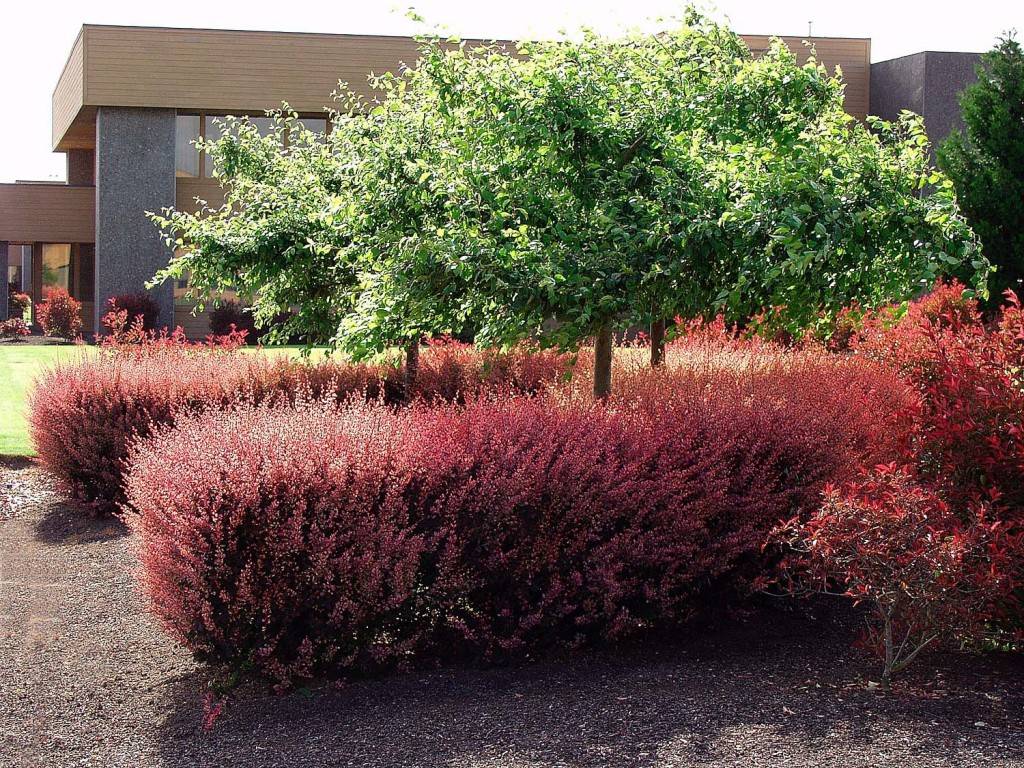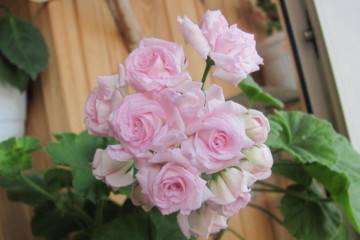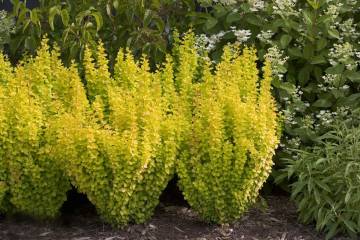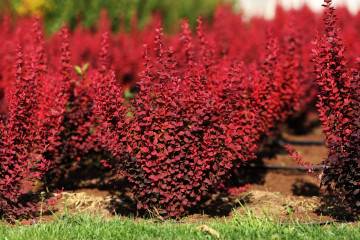Barberry Rose Glow - variety description and care
Content:
Barberry Rose Glow is an ornamental shrub, the leaves of which are a real decoration of the local area. From a distance it seems that he is all in the colors of a pink-burgundy color. Below is information on growing the Thunberg Barberry (Berberis Thunbergii) Rose Glow plant on a personal plot.
Description of barberry Rose Glow
It is a deciduous shrub 1.5 m high. The crown is spreading, its diameter reaches 2 m. The annual growth of shoots is 15 cm. Young leaves are pink in color. There are gray and white spots all over the surface. Over time, the foliage becomes purple in color.
Gardeners speak positively about the characteristics of Rose Glow barberry. They note the following qualities of the plant:
- unpretentious care;
- drought resistance;
- frost resistance;
- good immunity;
- beautiful appearance.
The shrub is popular with both landscape designers and amateur gardeners.
Planting a plant
Rose Glow barberry is purchased in the garden center by seeds or in the form of seedlings.
Planting from seeds
The procedure begins in the fall. The peculiarity of barberry seeds is that they require long-term maintenance at low temperatures. Therefore, after harvesting, they are washed out of the fruit, dried and immediately sown in the ground.
The first shoots will appear by summer. They are allowed to grow up, then they are seated in a permanent place.
Planting seedlings in open ground
Young bushes can be planted on the site in spring and autumn. If you purchased a barberry grown in a container, it can be planted in the summer. Seedlings are planted as follows:
- Dig a hole, the depth and diameter of which should be 2 times the root system of the barberry.
- Stones, broken shards, expanded clay are laid out on the bottom.
- Then poured fertile soil, consisting of garden soil, humus, sand.
- A seedling is placed in the middle of the hole, the roots are straightened.
- Fall asleep with soil, watered.
The trunk circle is mulched with peat, straw, sawdust.
How to care
Crop care consists in watering as needed, feeding, weeding and loosening the soil, sanitary and formative pruning.
Watering
The bushes are often watered immediately after planting. In the future, this should be done only in dry summers. Water for irrigation is used soft, settled. Irrigate the ground in the morning or in the evening.
Top dressing
They begin to fertilize the bushes the next year after planting. The procedure is carried out three times per season. In the spring, nitrogen-containing substances are introduced, for example, a urea solution. Organics are used once every 3 years.
Pruning
In the spring, they perform sanitary pruning, removing frozen, dry, broken branches. If the bushes are used as a hedge, the next year, the shoots are cut in half. The procedure promotes better tillering of the branches.
By pruning barberry bushes, you can give them different shapes. Adult plants begin to bare from below, and they are cut to a stump. After that, they grow new shoots, regain their decorative appearance.
Reproduction methods
On the site, barberry can be propagated by seeds, cuttings, dividing the bush, layering.
Seeds
This method is time consuming, so gardeners usually do not use it. In addition, all parental qualities may not be transmitted. In order for the seeds to sprout, they need to be kept for 2-4 months at a temperature of 2-5 ° C.
Therefore, if the gardener still wants to use seed reproduction, the procedure should be started in the fall. During the winter, the seed will naturally undergo the necessary stratification.
Cuttings
Barberry is propagated in this way in early June. The procedure is performed as follows:
- Cut the cuttings about 10 cm long.
- The lower leaves are removed, the upper ones are cut in half.
- Dip the lower sections in the powder of the rooting stimulant.
- They are planted in a box with loose earth, watered.
- Cover with foil.
Dividing the bush
A plant older than 3 years old can be divided. The procedure is carried out in the spring. The bush is dug up, divided into several parts. New plants should have branches and a root system. Places of cuts are sprinkled with crushed charcoal and planted.
Layers
For reproduction in the spring, grooves are made into which the lower branches are lowered. They are pinned, watered, covered with earth. By the end of the season, they will take root. The next year, young bushes are separated from the parent plant and transplanted to a permanent place.
Transfer
Barberry is transplanted in spring or autumn. Choose a well-lit area for it. In the shade, the leaves will not show themselves in all their glory. Groundwater should not approach the soil surface closer than 1.5 m. When transplanting barberry, the roots and shoots are slightly pruned.
Diseases and pests
Barberry does not like excess moisture, therefore, in a rainy summer, it can be affected by powdery mildew. To save the plant, the affected parts are removed, the bush is sprayed several times with copper-containing preparations.
Also, barberry can be affected by bacteriosis, rust, spotting. To prevent diseases, the bushes need to be treated with antifungal drugs 2-3 times per season.
A common crop pest is the barberry aphid. Insecticides are used to control insects.
Flowering period
In the description of the barberry Rose Glow, it is indicated that the buds bloom in late May or early June. Inside, the flowers are red, outside they are yellow. They can be single or collected in small brushes. After flowering, coral fruits are formed. They ripen by the end of September, they do not crumble even in winter.
Preparing for winter
Young bushes, especially those planted in autumn, are sheltered for the winter. First, they are spudded, then covered with agrofibre. Adult bushes do not need insulation. They cover the plants after the sub-zero temperature lasts for several days. If the procedure is started prematurely, the bushes may vanish.
Use in landscape design
Barberry Rose Glow is loved by specialists and ordinary gardeners. They use it in design as follows:
- as a hedge;
- singly against the background of lawn grass;
- combined with other barberries with light foliage;
- tall evergreen conifers are planted in the middle ground;
- planted in a mixborder with plants that have a contrasting color;
- create topiary from bushes.
Beneficial features
In folk medicine, all parts of the barberry are used. They help to strengthen the immune system, relieve inflammation from the organs of the gastrointestinal tract, lose weight due to diuretic and laxative properties. But, before starting treatment with alternative methods, you must definitely consult your doctor.
Rose Glow barberry Thunberg is a plant with beautiful pink-burgundy leaves. The bushes are unpretentious to care for, even inexperienced gardeners can grow them. Plants overwinter well without shelter, withstand a slight drought without losing their decorative effect.




















